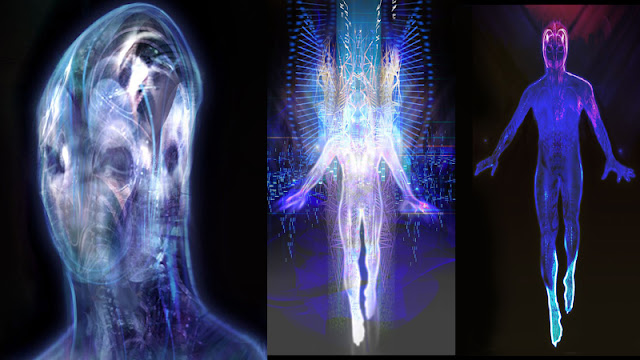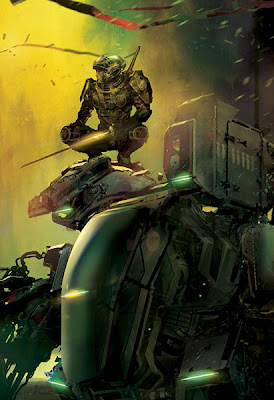Stephan Martiniere has worked on films, books, games, and even designing amusement parks among other things. Recently, he just published a fantastic art book called Velocity (also available in a Limited Edition version!).
Before reading the interview he gave us, be sure to check out his expansive portfolio.
LA! A major step between a student and a professional is a solid portfolio. How did/do you approach building yours? Are book portfolios still in demand?
Stephan: One of the advantages of a book portfolio is the face to face interview you have with the client; you can verbally expand on each image, talk about the technique used and sell your personality. You can also sense how the client reacts to the work and direct him to the works that will matter to him. But as in depth as these interviews can be they are time consuming and costly if you have to travel long distances to meet the client, you also need several portfolios if you need to send it to several places at once. But this was then. When computer started to become more of a common thing I created CD portfolio, this allowed me to create something more interactive with FX and sound, the cost was reasonable and I had multiple copies at my disposal. There were still a lot of clients who wanted to see me be I could always leave them the several CD to be passed around after the interview. Now days with the Internet being part of everyday life I direct clients to my web site.
Mine is relatively straight forward but today artist can go more complex and be very creative if they want to. There is no need for a CD for me anymore but the book portfolio is still very relevant. I do a lot of shows and lectures and sometimes there is no computer at your disposal. The lower cost of printing also allows a lot of artists to create many different types of portfolios, from fancy brochures to mini books, there are a lot of creative and relatively inexpensive ways to reach clients. I do a lot of brochures, flyers, cards and now that I have three art books I can use them and offer them as well when necessary. I always tell aspiring artists and beginners to be prepared for anything, so having multiple options is a must. In terms of how I present my art whether in a book portfolio or online I tend to tailor it to work for all my different clients so it is divided right away in categories ranging from creatures and robot, characters, to books, animation, games, environment etc, so my clients can quickly go to what interest them.
LA! Quite often students of the arts are told things like “it’s all about connections”. How true is this mindset and how did/do you approach forging your connections?
Stephan: In my opinion, good work will always get you there, its just a matter of time, but connections are very important and having them will most likely get your foot in the door faster. I guess it’s more about how much in a hurry you are. For me my connections happened slowly but steadily. I was also working in many different industries at the same time so it took a little longer to build a solid network. The market is constantly changing so making connections never stops; I am still making connections every week. I believe as long as you stay relevant as an artist you ll keep making more connections. The hardest part when you are connected to so many is to stay connected.
LA! As an artist in this technologically advanced age do you find yourself returning to fine art or digital? What mediums do you utilize the most?
Stephan: I was trained traditionally and that has never left me, I still use pencil and paper in one form or another regardless of how much digital I use. My primary digital tool is Photoshop, then Painter but I now also use more and more 3D software such as 3d studio max, Sculptris, or 3d coat these tools allow me to expend my creativity and help me with complex ideas as well as to achieve different results. These softwares are incredible, they have reshaped my career and I hope they will continue to do that in the years to come but as cool as they are there is still no feel like a pencil on paper or a brush on board or canvas. I remember when I was working at Cyan on Myst 5, I had to come up with a series of characters and I had to choose how to execute them, my choice was to approach the execution as if different fictitious artist’s from different Myst periods, had drawn these. This decision allowed me to go back to drawing in charcoal on big size paper, a thing I hadn't done since school.
I remember how frustrated I was at the beginning; nothing was coming out right and my garbage bin was filling up with one failed attempt after another, but drawing is like a bicycle. Once you've learned it, you never forget. It took me several days and I remember the intensity and pleasure once it started to come back, the large and bold gestures with your hands smearing the charcoal on the paper, digital can't give you that feel. Even on a smaller scale, when I draw with a regular pencil, there is a precision in my gesture that I cannot emulate on a tablet or even a Cintiq. All in all I am glad I can switch from digital to traditional and enjoy both.
LA! What do you find to be the best tools for self promotion?
Stephan: These days I would say my online portfolio, my art books and emailing and updating clients on my new works.
LA! How often did you “work out” artistically in order to reach the level of excellence you currently enjoy? Do you still practice as often or does it eventually just come naturally?
Stephan: I am trying a lot of new things lately, as I mentioned previously I am using 3D more and more and I am very demanding with myself so there will be a lot of practice, trials and errors to reach the comfort zone I'd like to be in. This was the same way when I started with Photoshop. I just knew I had to learn it. I could see what I could do with it and that inspired me for many years. I am obviously a lot more comfortable with it now. Once the technicality is not an issue all the concentration goes to the creative aspect of the work and that's when cool things start happening. When I started with Photoshop it was important to me to find an artistic signature and that forced me to push the envelop and explore different ways to use the software. Over the years I was able to find some very unique and personal ways to paint with some satisfying results. A lot of what I do now comes naturally and that's a good thing. It allows me to be fast and efficient but there is still a part of me who keep looking for new challenges and 3D seems to be the new frontier for me.
LA! What advice would you give an artist wishing to use their creative talents as a career?
Stephan: There are tons of artistic possibilities out there. When I was younger I never fully realized how many artistic options existed. I would say that for anyone wanting to make a career as an artist, knowledge is the key. Today with the Internet at everyone's fingertips there is no excuse for an aspiring artist not to know what possibilities are out there. Films or games are cool but not necessarily the coolest fields one could aspire to work in. There are fields such as art, photography, fashion, graphic or web designs, industrial design, publishing etc, the list is long. The important thing is to always be curious and once one picks an avenue, do more research in depth. I always tell students, "know your industry, find out who's out there, the schools, companies, what and how they do things, who is your competition etc. The more you know, the better your chances”.
LA! As a professional artist, what is the most common "rookie mistake" you see?
Stephan: I would say the most frequent I see from “rookies” is not having enough solid artistic foundations to support their art. Another mistake I see a lot is the tendency for students to embrace a popular technique without fully understanding it thus mimicking and only scratching the surface but this is also due to the lack of the basic artistic foundations mentioned above. The good news is that these common mistakes are not new, they take on a different form due to the new tools and techniques offered but they are part of the artistic process, digital or not, I used to make them myself too.
Many thanks to Stephan Martiniere for the advice and guidance. Be sure to check out his new book Velocity, and his killer-cool portfolio!
Until next time,
Josh Evans






No comments:
Post a Comment